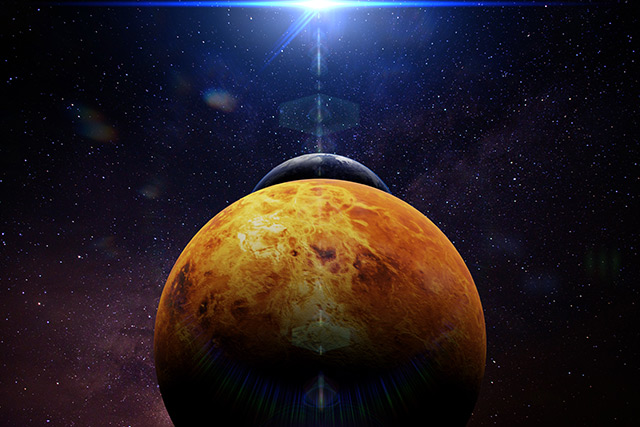Oxford researcher: Humanity should look for star-sized structures called “Dyson spheres” to find aliens
06/21/2021 / By Virgilio Marin

Anders Sandberg of the University of Oxford suggests looking for hypothetical star-sized structures called Dyson spheres to find aliens. He notes that if advanced alien civilizations do exist, they may have built one of these spheres and used it as a supercomputer, solar-capture technology or habitat.
“I think you can find a bunch of very different uses,” said Sandberg, who is a senior research fellow at the Oxford’s Future of Humanity Institute. “Energy collection is just one. You can, of course, talk about it as living space, which is usually what science fiction tends to do, because it creates an amazing sense of awe when you get so much space.”
What is a Dyson sphere?
A Dyson sphere is a theoretical mega-structure that encircles a star with platforms in tight formation. It is the “ultimate solution” to a lack of living space and insufficient energy production, as it provides enough room for habitation and can capture all the energy emitted by the star.
The structure was named after British-American mathematician Freeman Dyson, who first speculated about Dyson spheres in 1960. He suggested that the land area and energy needs of an intelligent alien species would grow exponentially as its population and industries grew at a modest one percent per year.
To ensure its survival, the alien race would build a structure bigger than its star. Called a Dyson sphere, the structure would be built by taking apart a Jupiter-sized planet and spreading its mass in a spherical shell. The shell would then be placed at twice the Earth-sun distance and could be made comfortably habitable, Dyson said.
However, his idea did not take off at the time because it was quite radical. “What Freeman Dyson did in his Dyson sphere paper is of course point out that, actually, we might want to look for industrial activities that are not intended to communicate,” Sandberg said, referring to the fact that the Search for Extraterrestrial Intelligence’s (SETI) efforts decades ago consisted mostly of listening for strange radio signals.
“It’s just that [aliens] create structures that we would not normally see in nature and that would be very visible because they’re so extreme. And that was a crazy idea back in the sixties and seventies. People were not really ready for it.”
In 1999, Sandberg published a paper that discussed how Dyson spheres would work. He hypothesized that these mega-structures would probably be used as star-size supercomputers to power an advanced artificial intelligence, which he playfully called “Jupiter brain.”
He was inspired to use the term after other scientists joked about literally converting Jupiter into a giant computer. “There are some practical problems with that, mostly cooling, but the name is kind of quite cool to play around with,” the Oxford fellow said. (Related: Study: There are 36 other ALIEN CIVILIZATIONS in our own galaxy, but humanity is too far away to communicate with them.)
Dyson spheres are hard to spot despite their size
Sandberg said that fully operational Dyson spheres would be visible over several light-years because they are bigger than the stars they surround and give off tremendous amounts of heat and energy. But if Dyson spheres do exist, they are hard to spot at the moment because they might be currently inactive, according to Sandberg.
In 2017, the Oxford fellow led a study that attempted to resolve the Fermi paradox, which is the apparent contradiction between the lack of evidence for ET and various high estimates for its probability.
He and his colleagues argued that a Dyson sphere is currently estivating – or hibernating – because its makers might be waiting for when its star has begun to run out of energy. If a Dyson sphere were to be fully activated only after that, it would be more efficient because it would operate better in a low-temperature environment.
“We hence suggest the ‘aestivation hypothesis’ – the reason we are not observing manifestations of alien civilizations is that they are currently (mostly) inactive, patiently waiting for future cosmic eras,” the researchers wrote. (Related: Astronomers detect mysterious radio signal coming from neighboring star.)
However, SETI astronomers might still be able to spot a Dyson sphere by looking at certain signatures. Sandberg said that humanity could look for the infrared energy that such a structure emitted, plus unusual light curves which could indicate the presence of alien-made materials.
Space.news has more about the search for alien life.
Sources include:
Tagged Under: advanced alien civilizations, alien civilizations, alien life, cosmic, Dyson Sphere, ET, extraterrestrials, Fermi paradox, future science, SETI, Space, space exploration, Stars
RECENT NEWS & ARTICLES
COPYRIGHT © 2017 SPACE.COM
All content posted on this site is protected under Free Speech. Space.com is not responsible for content written by contributing authors. The information on this site is provided for educational and entertainment purposes only. It is not intended as a substitute for professional advice of any kind. Space.com assumes no responsibility for the use or misuse of this material. All trademarks, registered trademarks and service marks mentioned on this site are the property of their respective owners.





















